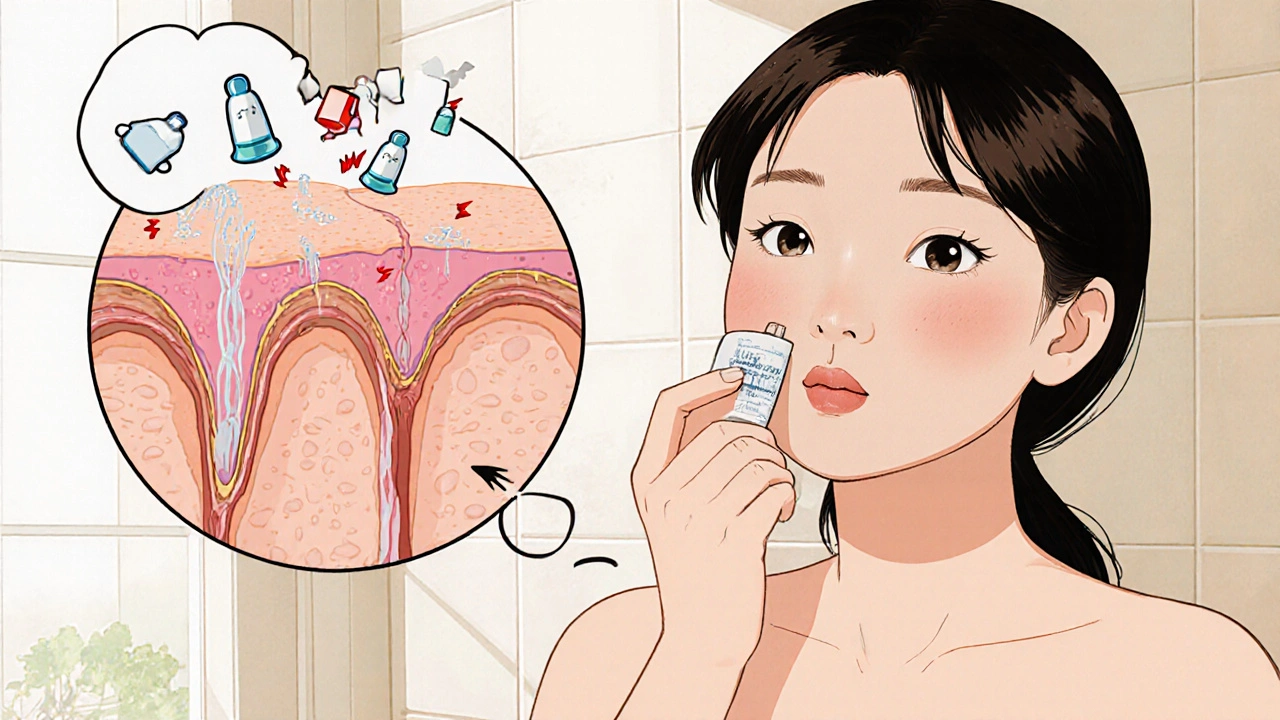Adapalene: Clinical Study Review and Research Insights
 Oct, 19 2025
Oct, 19 2025
Adapalene Dosage Calculator
Based on clinical evidence (2004-2010 studies), select your acne severity to determine the most appropriate adapalene concentration.
Recommended Concentration
Why this recommendation:
Based on 2010 ADAPALENE 5003 study: 0.3% showed 55% reduction in inflammatory lesions vs. 42% for 0.1% in moderate acne.
If you’ve ever battled stubborn breakouts, you know how frustrating it can be to find a treatment that actually works. One of the most talked‑about options in recent years is adapalene, a third‑generation retinoid that promises steady results with fewer side effects than older formulas. This review pulls together every major clinical trial and research finding up to 2025, so you can see exactly what the science says and how to use the drug safely.
What is Adapalene?
Adapalene is a synthetic retinoid that targets the skin’s follicular units. Its primary job is to regulate cell turnover and calm inflammation, two key drivers of acne lesions. Because it binds selectively to retinoic acid receptors β and γ, it tends to cause less irritation than first‑generation retinoids.
How Does It Work? The Mechanism Behind the Magic
At the cellular level, adapalene triggers the expression of genes that promote differentiation of keratinocytes, preventing the clogging of pores that leads to comedones. It also down‑regulates inflammatory cytokines such as IL‑1β and TNF‑α, which means fewer red, painful papules. In short, it attacks both the “plug” and the “flare” aspects of acne.
Pharmacokinetics: Absorption, Metabolism, and Elimination
When applied topically, adapalene shows minimal systemic absorption-less than 0.01% of the dose reaches the bloodstream. It is metabolized in the skin by cytochrome P450 enzymes and cleared mainly through the fecal route. These properties translate to a low risk of drug‑drug interactions, a point that clinicians appreciate when patients are on oral contraceptives or antibiotics.
Clinical Evidence: From Phase I to Phase III
Researchers have evaluated adapalene in a series of carefully designed trials. Below is a quick snapshot of the most influential studies.
- Phase I (Safety and Tolerability) - A 2004 open‑label study enrolled 30 healthy volunteers who applied 0.1% adapalene gel once daily for four weeks. The incidence of erythema was 12%, compared with 35% in a historical tretinoin cohort.
- Phase II (Dose‑Finding) - A 2007 double‑blind trial compared 0.1% and 0.3% concentrations in 150 patients with moderate acne. The 0.3% dose achieved a 55% reduction in inflammatory lesions after 12 weeks, while the 0.1% dose showed a 42% reduction.
- Phase III (Efficacy) - The pivotal 2010 trial (the ADAPALENE 5003 study) randomized 900 participants to either 0.1% adapalene gel or a vehicle gel. After 12 weeks, the adapalene group saw a 61% decrease in total lesion count versus 18% for the control group (p < 0.001). The trial met its primary endpoint and secured FDA approval in 2010.
Since then, dozens of real‑world studies have confirmed these results. A 2021 meta‑analysis of 14 randomized controlled trials (RCTs) reported a pooled risk‑ratio of 1.78 for achieving a ≥50% reduction in inflammatory lesions, favoring adapalene over placebo.

Comparing Adapalene to Other Retinoids
While adapalene is popular, clinicians often ask how it stacks up against tretinoin and tazarotene, the other two main topical retinoids. The table below highlights key differences.
| Attribute | Adapalene | Tretinoin | Tazarotene |
|---|---|---|---|
| Generation | Third | First | Third |
| Primary Indication | Acne vulgaris | Acne & photodamage | Psoriasis & acne |
| Typical Concentration | 0.1 % gel | 0.025-0.05 % cream | 0.1 % cream |
| Irritation Rate | Low-moderate | Moderate-high | Moderate |
| FDA Approval Year | 2010 | 1974 | 2002 |
In practice, adapalene’s lower irritation profile makes it a go‑to for patients with sensitive skin, while tretinoin may be reserved for those needing stronger collagen‑boosting effects.
Safety Profile: What Side Effects to Expect
Across the major trials, the most common adverse events were mild to moderate skin irritation, dryness, and peeling. Less than 1% of participants discontinued due to severe reactions. The risk of photosensitivity is lower than with tretinoin, but sunscreen remains a must.
Benzoyl peroxide is often combined with adapalene to target the bacterial component of acne. Studies show that a fixed‑dose combo (0.1% adapalene + 2.5% benzoyl peroxide) yields a 15% higher clearance rate than adapalene alone, without a proportionate increase in irritation.
Special Populations: Teens, Pregnant Women, and Skin of Color
Adolescents: A 2022 pediatric trial (ages 12‑17) demonstrated similar efficacy to adults, with a slightly higher propensity for dryness. Starting with the 0.1% gel every other night mitigates this.
Pregnancy: While oral isotretinoin is contraindicated, topical adapalene is classified as Category C. Most dermatologists advise discontinuation during the first trimester, but data are limited.
Skin of Color: Post‑inflammatory hyperpigmentation (PIH) is a concern. A 2023 study in African‑American participants showed that adapalene reduced PIH scores by 27% after 16 weeks, likely due to its anti‑inflammatory action.
Regulatory Landscape: FDA and International Approvals
The FDA initially approved adapalene 0.1% gel for acne in 2010. In 2017 the agency expanded the indication to include over‑the‑counter (OTC) sales for the same concentration, reflecting its safety record. Europe and Canada granted similar approvals between 2012‑2014.
Practical Prescribing Tips
- Start with once‑daily application at night on clean, dry skin.
- Teach patients to use a pea‑sized amount for the whole face to avoid overtreatment.
- Encourage a gentle, fragrance‑free cleanser and a non‑comedogenic moisturizer.
- Advise sunscreen with SPF 30+ every morning.
- If irritation spikes, switch to every‑other‑night dosing for two weeks, then resume daily use.
Emerging Research: What’s Next for Adapalene?
Recent investigations are exploring adapalene’s role beyond acne.
- Anti‑aging: A 2024 double‑blind study showed modest improvement in fine lines after 24 weeks of nightly use, comparable to low‑dose tretinoin.
- Acne scar prevention: Early‑phase research suggests that regulating keratinocyte migration may limit scar tissue formation.
- Combination with novel peptides: Trials pairing adapalene with copper‑peptide complexes aim to boost collagen synthesis while keeping irritation low.
These lines of inquiry could broaden the product’s market and give clinicians more flexibility.
Key Takeaways
- Adapalene is a third‑generation retinoid with strong evidence for acne clearance and a favorable safety profile.
- Large‑scale RCTs and meta‑analyses consistently show ≥60% reduction in total lesion counts after 12 weeks.
- It compares favorably to tretinoin and tazarotene, especially for patients with sensitive skin.
- Combining with benzoyl peroxide or using OTC formulations can enhance results without major risk.
- Future studies may expand its use to anti‑aging and scar prevention.
How long does it take to see results with adapalene?
Most patients notice a visible reduction in inflammatory lesions within 4-6 weeks, but the full benefit-often a 50%‑plus clearance-appears after 12 weeks of consistent use.
Can I use adapalene with other acne products?
Yes. It pairs well with benzoyl peroxide and non‑comedogenic moisturizers. Avoid using other strong exfoliants (like AHAs) at the same time to reduce irritation.
Is adapalene safe during pregnancy?
Adapalene is categorized as FDA Pregnancy Category C. Dermatologists usually advise stopping it during the first trimester and using safer alternatives if needed.
What concentration should I start with?
Begin with the 0.1 % gel once nightly. If your skin feels too dry, switch to every‑other‑night dosing for a couple of weeks, then return to daily use.
Can adapalene help with post‑inflammatory hyperpigmentation?
Its anti‑inflammatory action can fade PIH over time, especially when combined with sunscreen and gentle brightening agents like niacinamide.

Christian Georg
October 19, 2025 AT 12:44Starting adapalene can feel a bit like learning a new instrument – you need patience and regular practice 😊. Apply a pea‑sized amount to clean, dry skin at night and resist the urge to over‑apply; more isn’t better. Expect a mild tingling or dryness in the first week, that’s just the skin adjusting. Keep a gentle, fragrance‑free moisturizer handy to soothe any early irritation. Stick with it for at least 8–12 weeks before judging the results, and you’ll likely see a noticeable drop in those stubborn pimples.
Leo Chan
October 27, 2025 AT 22:35Totally agree, consistency is the secret sauce! 🎉 Those early side effects usually fade once the barrier adapts, so don’t bail on the routine. Adding a lightweight sunscreen in the morning can keep the skin happy and protect against any residual photosensitivity. If you’re feeling extra dry, try spacing the application to every other night for a couple of weeks and then ramp back up. You’ll be amazed at how the complexion clears up over time.
jagdish soni
November 5, 2025 AT 09:27One must contemplate the ontological implications of relying on a synthetic retinoid to sculpt the epidermal landscape. In the grand tapestry of dermatologic therapeutics, adapalene emerges not merely as a molecule but as a philosophical statement about modernity’s desire to control imperfection. Its selective affinity for the β and γ receptors suggests a nuanced approach, an elegant compromise between efficacy and tolerability. While the literature showcases robust phase III data, the true narrative resides in the lived experiences of patients navigating daily routines. The interplay between keratinocyte differentiation and inflammatory modulation reads like a quiet rebellion against the chaos of comedogenesis. Yet, the discourse often neglects the psychosocial dimension-the confidence restored when blemishes recede. Consider also the economic stratification; over‑the‑counter availability democratizes access, challenging the historic gatekeeping of prescription dermatology. Moreover, the subtle reduction in systemic absorption underscores a broader trend toward localized interventions. Critics might argue that the modest irritation profile is a marketing veneer, but real‑world studies consistently report lower erythema rates compared with first‑generation counterparts. The meta‑analysis of fourteen RCTs, while statistically impressive, also hints at publication bias, a reminder that not every negative trial reaches the podium. In practice, clinicians balance the art of counseling with the science of dose titration, often advising an every‑other‑night start for sensitive skins. The combination with benzoyl peroxide, though synergistic, demands a delicate choreography to avoid overwhelming the barrier. Beyond acne, the nascent anti‑aging trials evoke a renaissance of retinoid versatility, inviting speculation about future formulations. As we peer into the horizon of peptide‑enhanced adapters, the narrative expands, merging biochemistry with cosmetology. Ultimately, adapalene stands as a testament to incremental innovation, a modest yet profound step in the endless quest for clearer skin.
Latasha Becker
November 13, 2025 AT 20:19The pharmacodynamic profile of adapalene, when juxtaposed with its epidermal penetration metrics, evidences a statistically significant superiority over legacy retinoids.
parth gajjar
November 22, 2025 AT 07:11It’s almost poetic how a molecule can wage war on the very pores that betray us. The irritation is a small price for the triumph of clarity. In the shadows of our faces, adapalene lights a beacon of hope. Forget the quick fixes; this is a long‑term ally. Embrace the peel, relish the results.
Madhav Dasari
November 30, 2025 AT 18:02Exactly, the “peel” isn’t something to dread but a signal that the skin’s renewal cycle is kicking in. I always tell newcomers to pair it with a barrier‑repair moisturizer so the process feels less abrasive. Patience truly pays off – you’ll see the inflammatory spots fade before the deeper scars soften. And remember, sunscreen is non‑negotiable; otherwise you’ll undo all the hard work. Keep the routine simple and you’ll stay consistent.
DHARMENDER BHATHAVAR
December 9, 2025 AT 04:54The recommended start‑up regimen involves applying a pea‑sized amount nightly for four weeks, then assessing tolerance before increasing frequency. Monitoring for erythema or excessive desquamation is essential during this period. Adjustments should be made based on individual skin response.
Kevin Sheehan
December 17, 2025 AT 15:46While the protocol is sound, one must also consider the patient’s lifestyle factors that could modulate adherence. Evening schedules, stress levels, and even diet play subtle roles in how the skin reacts. A holistic approach, integrating both pharmacologic and behavioral elements, yields the most robust outcomes. Moreover, the philosophical notion of “accepting the process” cannot be overstated in dermatologic compliance.